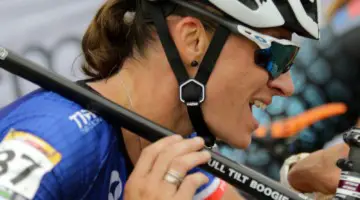
Expect to see some homebrew brake solutions like this as racers try to comply with new UCI regulations for the 2012 cyclocross season. © Paul Guerra
by Paul Guerra
Due to slower-than-expected adoption of disc brakes at the top level of the sport after their legalization a year ago, the UCI has made the surprising off-season decision to mandate the use of them at all UCI-sanctioned cyclocross races, effective January 1, 2012. Meanwhile, the governing body has also decided to further extended its controversial frame approval stickering program to cover cycling gloves and shoes.
According to Didier Müller, UCI Undersecretary of Technology Regulation Enforcement, the regulation stems from an event involving UCI President Pat McQuaid in January of this year. McQuaid attended the Swiss National Championships held in Hittnau, Switzerland. After the race, McQuaid engaged winner Christian Heule in a discussion regarding his equipment and even took Heule’s race-winning steed for a test ride. Soft-pedaling in wingtips and an overcoat and gloveless, McQuaid managed a shaky lap around the course until the first downhill. On this descent, while attempting to brake on the slick wet ground, McQuaid crashed through the barrier tape and into a tree.
“How can anyone brake with these old-fashioned contraptions?” asked the UCI chief. Blaming his inability to brake on cold hands and the bike’s wide-profile cantilever brakes and his loss of control of the bike on his slick soled shoes, McQuaid tasked his lieutenants with creating additional necessary cyclocross equipment standards for the upcoming season.
The new brake standard is perhaps the most difficult for racers to comply with. Equipment makers are hastily assembling their engineering teams to redesign frames to handle disc brakes in time to field sponsored teams in the fall so they won’t have to switch bikes just before January’s important races.
Will we see more of Tim Cannard's cable-to-hydraulic converters with the new UCI rule? © Cyclocross Magazine
“It’s not as simple as chopping off the cantilever posts and welding on some disc tabs” said Zack Smithers, Specialized engineer and team leader for the Crux cyclocross bike project. “We just finished the carbon design of our latest ‘cross bike, the Crux, and really tuned all the tubing geometry for the loads it was going to see and it was built to be UCI compliant and would certainly meet the sticker standards. But now this? Disc brakes really stress the frame differently, and changing carbon molds for forks and seat stays isn’t exactly something you can do with a snap of your fingers.”
When asked what this meant for the future of Specialized sponsored squads such as Cal Giant Strawberries, Smithers said “I don’t even care, this is ridiculous.” He explained the deeper history of Specialized bikes being banned by the UCI, and pondered, “I just might see if I can move over to the Langster department where they just spend all day listening to the Plain White T’s and thinking of cool cities to name the bikes after.”
Echoing Specialized’s frustration, many racers, sponsored and not, are wondering how they’re going to comply financially with the new requirement, especially if they want to race at UCI sanctioned races or USA Cycling’s National Champioinships in Madison, Wisconsin.
Cat 3 racer Dirk Reggab summed it up best when he said “I reluctantly upgraded last season, just so I could race in Bend, and blam! I had to invest in brand new tires for all my carbon rims. I mean, I was literally throwing away barely used Dugast tubulars, cutting them off my rims with a razor blade. And now this? I can’t race at Nats in 2012 without a new frame? I can’t afford cyclocross anymore. And to think I started this sport on a hybrid.”
To add to rider’s equipment woes for the fall, the new shoe and glove requirements will require additional investment (see our Shoe Week reviews and our slew of glove reviews in Issue 11). The clothing approval process will be similar to the frame approval process we reported on, but because stickers cannot be permanently affixed to gloves or shoes, a special embroidered patch featuring the UCI logo has been created and must be sewn into the fabric of the approved apparel. This means that existing apparel, even it’s conforming to the standards, cannot be used, it must be replaced. We can’t help but wonder if it’s just a matter of time before someone comes up with a satirical version of such a patch as we’ve seen with the UCI frame sticker.
As for the standard’s full details, stay tuned. The 271 page ‘Memorandum on the Homologation and Harmonization of Hand and Footware Design Standards for Cyclocross Racing’ has not yet arrived at our offices yet. The handbook reportedly has four pages dedicated to the measurement of shoe toe spike length alone. A couple highlights we could glean from an early draft we reviewed are:
Gloves:
● Gloves must be half-fingered for all races in which the starting temperature exceeds 10˚C and full fingered for all races starting at below 10˚C, unless the presiding official decides otherwise. Embrocation cannot be used as a substitute for gloves.
● All gloves may not have a nose wipe bigger than two square centimeters to avoid “unclean appearances” on television
Shoes:
● Toe spikes may only be worn in races in which, at the time of the start, the mean mud depth on the course exceeds 1.5 centimeters or snow exists on any run-up exceeding π/12 radians
● Toe spike protrusion from the sole must not exceed 1/24 the height of the tallest barrier on the course, so as to avoid toe clipping face plants.
● Shoes must be at least 70% black or white to better “respect the sport.” Yellow or red cycling shoes made popular recently are no longer allowed as they call attention to the individual as opposed to the sport.
It remains unclear whether USA Cycling will adopt such rules for its non-UCI sanctioned events.
When combined with the new UCI frame approval rules, the new rules represent quite a bit of change, and will result in significant retooling for manufacturers and an inventory management headache for retail outlets. Yet the UCI indicated that it’s not yet satisfied with the new regulations in place for cyclocross. In regards to the scope of the mandate changes, the UCI’s Müller told Cyclocross Magazine, “Hold on to your hats, guys, we’ve got standards for socks and sunglasses coming out for 2012-2013, plus a new Masters Cyclocross World Cup. The UCI is starting to take cyclocross seriously.”
Stay tuned to Cyclocross Magazine as we research these new rules.




























